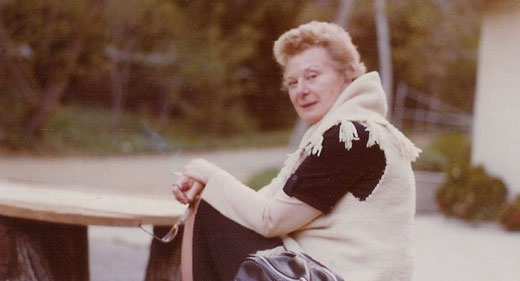Over sixty-five years ago, Virginia Satir began therapeutic work with people, first as a school teacher, and later as a social worker.

Through years of work in the field of psychology, she developed her own approach of working with families.
Namka (2003) described Satir as warm, brilliant, and knowledgeable of the pain of being human. According to Namka, Satir steered the mental health field away from the concept of pathology and toward the notion of people as a product of negative family patterns.
Family Theory: Satir (1983) rationalized that the primary goal of the family therapist is to deal with family pain. According to Satir, family pain manifests itself in the symptoms of one family member but extends itself to all family members in some shape or form. Satir distinguished the family member who carries the predominant symptom as the “Identified Patient,” or “I.P.”.
Satir (1983) believed that a pained marital relationship is likely to result in dysfunctional parentingpatterns. In effect, the Identified Patient is the family member who is most affected by the pained marital relationship and most subjected to dysfunctional parenting. Satir defined the Identified Patient’s symptoms as an “SOS” regarding his parents’ pain and the resulting family imbalance.
Satir (1983) described the family as an interacting unit that strives to achieve balance in relationshipsthrough the use of repetitious, circular, and predictable communication patterns. This phenomenon is known as family homeostasis. Satir described the spousal mates as the architects of the family and contended that the marital relationship is the axis around which all other family relationships are formed. Thus, family homeostasis is directly influenced by the marital relationship.
The Spousal Unit and Low Self-Esteem
Satir (1983) defined a person with low self-esteem as having a great sense of anxiety and uncertainty about himself. Thus, individuals suffering from low self-esteem tend to be more concerned with what others think of them and less concerned with how they feel about themselves. Satir contended that this lack of self confidence results in a dependence on others and cripples personal autonomy and individuality.
Satir (1983) contended that there are no accidents in the selection of a mate. According to Satir, an individual suffering from low self-esteem has high hopes about what he can expect from others but is also ready to expect disappointment and to distrust people. In effect, each individual sees something in his significant other which seems to fit his high expectations, as well as something which seems to corroborate his fears and distrust. For such individuals, Satir describes marriage as an effort to “get.” Satir believed that each mate desires the other’s esteem of him, as well as the other’s qualities which he feels he lacks. In addition, each mate finds in the other an extension of himself which allows for feelings of completeness and success.
Different-ness and Disagreements
Satir (1983) believed that when two people get married, they do not realize that they will have to give as well as get. This is directly related to self-esteem, as individuals suffering from low self-esteem feel they have nothing to offer and should not be expected to give. According to Satir, married couples who posess high self-esteem are better able to trust each other and to feel confident in their abilities to give to each other. This freedom to give results in the appreciation of individuality, or different-ness, and the ability to use this different-ness as an opportunity for growth.
Problems with different-ness arise when the married couple begins to see in each other “the twenty-four-hour-a-day characteristics which do not usually show up during courtship and do not fit each mate’s expectations of the other” (Satir, 1983, p. 13). Satir explained that when individuals begin to sense that they are different in ways that detract from their images rather than add to them, different-ness begins to look bad. In effect, different-ness is identified as a major source of disagreement.
The Introduction of Children
Satir (1983) believed that the need to “get” is a driving force in procreation. In effect, when a child enters into his parents’ world, his parents’ expectations and needs are there to greet him. Satir explained that troubles arise when the spousal unit realizes that the child is also out to “get.”
The introduction of children into the marital relationship creates an environment rich with mutually-reinforcing functions. Through the birth of a child, the marital unit is “contributing to the continuity of the race by producing and nurturing children and transmitting culture to the children by parental teaching” (Satir, 1983, p. 26). Satir further explained that the introduction of a child contributes to the division of labor between the adults and the child and serves as a means of eventual care of the parents by the child.
Bitter (1998) reported that Satir focuses on the relationship of the parents and the self-esteem exhibited in that relationship. According to Bitter, children are extremely reactive to parental influence, and when a couple’s relationship is marred by disappointment, the experience is often dealt with through the use of incongruent communication and defensive posturing. In effect, the spousal relationship thrives on communication that is altered by low self-worth, and the couple’s overwhelming defensiveness is a product of the difficulty of existing as an independent individual in an interdependent relationship. Bitter further explained that the child, having a continual need to survive, is forced to adjust to whatever the parents are willing to give. Satir (1983) stated that, “When dissention between the parents increases, a child’s deviant behavior may be a functional response to a dysfunctional system” (p. 48).
Effects of Marital Disappointment
Satir (1983) believed that married couples who are plagued by low self-esteem will inevitably create a dysfunctional family environment. In effect, a great indication of how a couple will fare as parents is the way in which the couple views its child. In a dysfunctional family, the parental unit views the child as a “vehicle for representing its worth in the community and for maintaining esteem about self and family” (Satir, 1983, p. 36).
The consequences of low self-esteem are evident in each parent’s relationship with his child, just as they are evident in each parent’s relationship with the other. Satir (1983) explained that in dysfunctional families each parent continues to view the spouse, as well as the child, as an extension of the self. In effect, both spouses expect the child to want the same things as them, to see the same things as them, and to do what they want when they want it done. According to Satir, problems arise when either parent challenges the other parent’s expectations for the child.
Marital Discord and Triangulation
Satir (1983) posited that when parents find themselves in divergence, the child simultaneously finds himself stuck between conflicting demands. Satir explained that in such situations, each parent begins to view the child as a potential ally against the other mate, as a messenger through whom communication can occur, and as a pacifier of the other mate. In effect, each parent’s controlling desire for an extension of himself results in the confusion of individual parenting motivations with marital conflict.
Satir (1983) stated that “If the mates have low self-esteem and little trust in each other … the child will be expected to serve crucial pain-relieving functions in the marital relationship”
(p. 57). According to Satir, there is no such thing as a relationship between three people, rather there are only shifting two-person relationships with the third person in the role of observer. As a result, over-developed parent-child relationships are likely to occur.
Satir (1983) defined a family triangle as a situation in which “the wife fears that her husband will be less interested in her, the husband fears that his wife will be less interested in him, and the child fears that he will not be the center of his parents’ world” (p. 73). Such family triangles can be functional or dysfunctional.
Satir (1983) contended that in the functional family triangle, the mates are confident in the strength of their own marital relationship and are unthreatened by the child’s fear of being left out. This type of triangle breeds healthy father-child and mother-child relationships and makes it obvious to the child that he can never be included in the spousal unit. Bitter (1988) contended that parents who function appropriately with each other have the resources to be the leaders of the family. Bitter explained that the child in this type of environment will grow, gain an identity and a place in the world, and develop a belief in the stability of relationships.
Satir (1983) explained that in the dysfunctional family triangle the mates lack confidence in their own marital relationship and already feel left out with each other. Because they are disappointed in the different-ness of each other, each mate begins to look toward the child to satisfy his unfulfilled needs. According to Satir, the child is then forced to side with one parent and to lose the other. In effect, the child who is identified as the I.P. is burdened with the responsibility of living for his parents.
Communication Theory
Satir (1983) attributed human survival to communication, whether verbal or non-verbal, conscious or unconscious. Mishlove (1995) reported that one of the points Satir made regarding communication is that we very often fail to communicate what we are feeling inside. In effect, we are compelled to believe that other people should be able to read our minds. According to Satir, “If you love someone and you don’t read their minds, they believe it’s because you don’t love them, because if you did, you would know ahead of time” (Mishlove, 1995, p. 143).
Satir (1972) described communication as “a huge umbrella that covers and affects all that goes on between human beings” (p. 30). In effect, communication plays a large part in determining what types of relationships an individual will have and what happens in the world around him. Satir believed that all communication is learned and referred to communication as “a film camera equipped with sound … that works only in the present, right here, right now, between you and me” (p. 31). As a result, Satir felt that individuals who cloud their minds with regret for the past or fear for the future engage in little to no growth or change.
Mishlove (1995) reported that Satir believed she could demonstrate the relationship between communication and health and illness, between intimacy and distancing, between competency and incompetency, and between making sense and not making sense. According to Mishlove, Satir believed that all of these things can be understood within the frame of how we interpret our communications. Moore and Kramer (1999) contended that the lack of clear communication resides in contradictions. Most often, contradictions occur between verbal and nonverbal messages. According to Moore and Kramer, these types of contradictions create a serious difficulty for their receiver, for a response “appropriate to one layer of the message constitutes an inappropriate one for another, contradictory layer” (p. 430).
Patterns of Communication
Satir, Stachowiak, and Taschman (1975) identified five ways in which people handle their communication while under stress. These communication patterns, or coping stances, are seen as “brave attempts to survive when you do not believe you can” (p. 48). Satir et al. distinguished four of these communication patterns as incongruent communications. Moore and Kramer (1999) defined incongruent communications as communications that lack true expression regarding what a person experiences and needs and that contain camouflaged messages that are intended to conceal vulnerability. According to Mishlove (1999), Satir believed that incongruent communicators avoid placing themselves in vulnerable positions where they might have to protect themselves. As a result, people lie most of the time.
Incongruent communication patterns are identified as blamer, placater, irrelevant, and super-reasonable. Moore and Kramer (1999) described blamers as people who gain strength and self-esteem through the disparagement of others. According to Satir (1972), the blamer is a fault-finder, a dictator, and a boss. In contrast, Satir identified placaters as people who belittle themselves while simultaneously inflating others. Thus, the placater is a “yes man,” who always tries to please, constantly apologizes, and never disagrees. Moore and Kramer explained that irrelevant people disregard their own opinions in an effort to avoid confrontation. As a result, irrelevant communicators lack self-worth, and their statements often appear completely unrelated to the subject matter at hand. Satir described super-reasonable communicators as unemotional and robot-like, possessing a strong desire to control both themselves and others. According to Moore and Kramer, super-reasonable communicators receive power from acting as if they know it all while simultaneously causing their audience to appear ignorant.
Satir, Stachowiak, and Taschman (1975) identified the fifth communication pattern as congruent. Congruent communication refers to communication that exhibits no incongruence within its own transmission. According to Moore and Kramer (1999), congruent communicators “share their thoughts and emotions about themselves without projecting them onto others and thus avoid manipulation” (p. 430).
Theory and Practice of Therapy
According to Banmen (1986), Satir’s model of family therapy is based on a general systems theory. Banmen stated, “Satir’s system describes a set of actions, reactions, and interactions among a set of variables essential to a single outcome and develops an order and a sequence among these variables to accomplish the desired outcome” (p. 482). In most cases, the desired outcome involves some form of change. Sayles (2002) reported that Satir’s process of change is a way to aid people in making choices that increase self-esteem, provide self-accountability or responsibility, and move a person toward congruence between the self and others.
View of People
Smith (2002) reported that Satir saw people as having three births. According to Smith, the first birth is the union of sperm and egg. This union serves as a manifestation of the life force. In effect, Satir held that individuals serve as the co-creators of their lives in conjunction with the life force. Smith contended that the inclusion of the life force is a spiritual foundation of the Satir model.
Smith (2002) described the second birth as the physical emergence from the womb. During this time, individuals enter into a pre-existing family system and are totally dependent upon their caregivers for survival. In effect, Satir believed that an individual’s beliefs regarding reality are entirely constructed through his interactions with his family of origin.
Smith (2002) identified the third birth as the moment at which an individual becomes his own decision maker. Satir (1983) contended that the most important concept in therapy is that of maturation, or the state in which an individual is fully in charge of himself and his choices. Banmen (1986) reported that Satir believed that family therapy works with enabling dysfunctional families to become functional by transforming patterns of behavior into patterns of choice. According to Banmen, Satir felt that self-esteem is a basic element in family therapy and maintained that low self-esteem affects the entire family system.
Stages of Change
Banmen (1986) contended that Satir looked at change from three possibilities:
(1) change is initiated out of survival needs, (2) change is initiated out of hope, and (3) change is initiated by acknowledgement of what is already happening. Banmen further explained that Satir identified four components as necessary to the continuation of change: (1) the family needs a loving atmosphere, (2) the family needs a sense of trust, (3) the change contemplated needs to be believable, and (4) family members need to be in limbo throughout the change process.
Sayles (2002) reported that the Satir model identifies six stages in the change process. These stages include Status Quo, Foreign Element, Chaos, Integration, Practice, and New Status Quo. According to Banmen (1986), stage one is whatever it is that draws attention to the need to move away from the status quo. Sayles described the status quo as a point of balance within the family system that comes at a high cost to one or multiple family members.
Banmen (1986) defined stage two as whatever it is that allows the wish for change. In effect, stage two introduces a foreign element into play. Sayles (2002) described the foreign element as an event that comes from outside of the family system. According to Sayles, as family members begin to accept patterns of dysfunction and explore expectations and beliefs, the process of change becomes more conscious. As a result, the family sytem begins to move away from the status quo toward the inevitable chaos.
Banmen (1986) explained that stage three introduces a family system in a state of chaos. Sayles (2002) described chaos as being characterized by a willingness on the part of the family members to risk moving into territory that is unknown and unfamiliar. Sayles further explained that new possibilities do not appear obvious to those living in an unbalanced family system. In effect, a point of transformation does not emerge until the family system has moved through the chaos stage.
Banmen (1986) described stage four as the process of integrating new information into the family system and alleviating fluctuation. Sayles (2002) contended that the integration of new experiences helps reduce the conflict that many family members feel when building a connection with a new self that has self-esteem. As a result, the therapist maintains an important role throughout this stage. According to Sayles, the therapist must use this stage to anchor the significant alterations in perceptions, feelings, beliefs, and behaviors.
Banmen (1986) referred to stage five as the practice stage, during which the family is confronted with the opportunity to grow through change. Sayles (2002) described the practice stage as the homework component of integrating a new behavior. As a result, this practice increases self-esteem and value as new information is used as the family members relate to themselves and to each other.
Techniques of the Therapist
Haber (2002) contended that Satir left an array of techniques that still remain functional and vital in the field of family therapy. Haber explained that all of Satir’s techniques are focused on creating change in larger systems while simultaneously respecting the congruence of smaller subsystems.
According to Sayles (2002), Satir spoke of change as another way of discussing life. Satir stated that change that is truly transforming is made in a “safe, trusting, and accepting environment” (Sayles, 2002, p. 97). In addition, Sayles contended that growth and change most frequently occur in open and functional systems, where people are heard, valued, validated, and acknowledged. Satir, Banmen, Gerber, and Gomori (1991) reported that the goal of transformation is not to completely eliminate what no longer works, but to add to what already exists in order to transform meaning and understanding.
Family Reconstruction
Banmen (1986) described family reconstruction as a process in which a person reenacts some chosen part of his or her childhood, reconstructing perceptions from new information, which results in different perceptions and ideas about oneself. Taylor (2002) contended that family reconstruction is important for its transformative possibilities. Satir, Banmen, Gerber, and Gomori (1991) stated:
Family reconstruction provides a way of seeing ourselves and our parents with new eyes and thus seeing the present and the future in a new perspective. This new perspective provides us with access to greater opportunities, more freedom, and an enhanced sense of responsibility. We can always change shit to compost! (p. 205)
Taylor defined compost as an extremely complex set of biological, regulated capacities which can be transformed into beneficial characteristics at many levels.
Beaudry (2002) identified several assumptions underlying family reconstruction. According to Beaudry, people are geared toward growth. In addition, people have within themselves all of the resources they need to grow or have interacted with someone who can model these resources for them. Beaudry believed that everyone and everything is affected by, and affects, everyone and everything in the family system. Thus, therapy is a process which takes place between persons in a positive and health-promoting context to accomplish a positive change.
Gilles (2002) reported that family reconstruction is usually done in large groups and takes one to three days. According to Gilles, the reconstruction process allows one person, identified as the Star, to reexperience his or her past, take a look at the present, and make plans for how things could change in the future. Taylor (2002) reported that the Star is selected through the conduction of personal interviews with family members who show an extreme willingness to change. Taylor added that for any number of reasons, the sequence of the processes within reconstruction may vary with any give Star and/or Guide. According to Gilles, therapeutic methods will allow the Star to heal by moving beyond thoughts, feelings, and patterns of behavior that are self-defeating.
Gilles (2002) contended that family reconstruction normally follows a four-act format: sculpting the family of origin; sculpting the families of origin of the Star’s mother and father; sculpting the Star’s parents’ meeting, courting, and wedding; and resculpting the Star’s family of origin. Taylor (2002) explained that with the Star, the therapist is able to determine which parts of the person’s history hold the most opportunity for growth. In most cases, change resulting from a reconstruction is immediate in the same way that new attitudes are.
Roles of the Therapist
Banmen (1986) reported that above all, the therapist must create an environment in which people are welcome to take the risk of looking clearly and objectively at themselves and their actions. In effect, it is essential to convey warmth, confidence, trust, and acceptance throughout the course of therapy. Banmen further explained that the role of the therapist is one of high engagement and activity and requires the therapist to become a model of open and direct communication. Satir believed that the therapist “must show the family how to change, how to get in touch with their own feelings, how to listen to others, and how to ask for clarification if they do not understand another person’s message” (Banmen, 1986, p. 490).
Smith (2002) reported that the therapist’s use of self is an important concept in therapy. Smith explained that Satir believed that through becoming aware of his or herself, the therapist will have access to more creative and flexible ways to authentically connect with the individual. Satir believed that “while therapists facilitate and enhance patients’ ability and need to grow, they should at the same time be aware that they have the same ability and need” (Smith, 2002, p.121).
Smith (2002) contended that a deep self-knowledge and confidence are necessary aspects of the therapist’s ability to be conscious of self. Satir described this as “being fully present in the moment, as the personhood of the therapist is not shed at the office door but brought into each and every interaction” (Smith, 2002, p. 122). In effect, Satir considered the use of self to be one of the most important instruments for change.








































